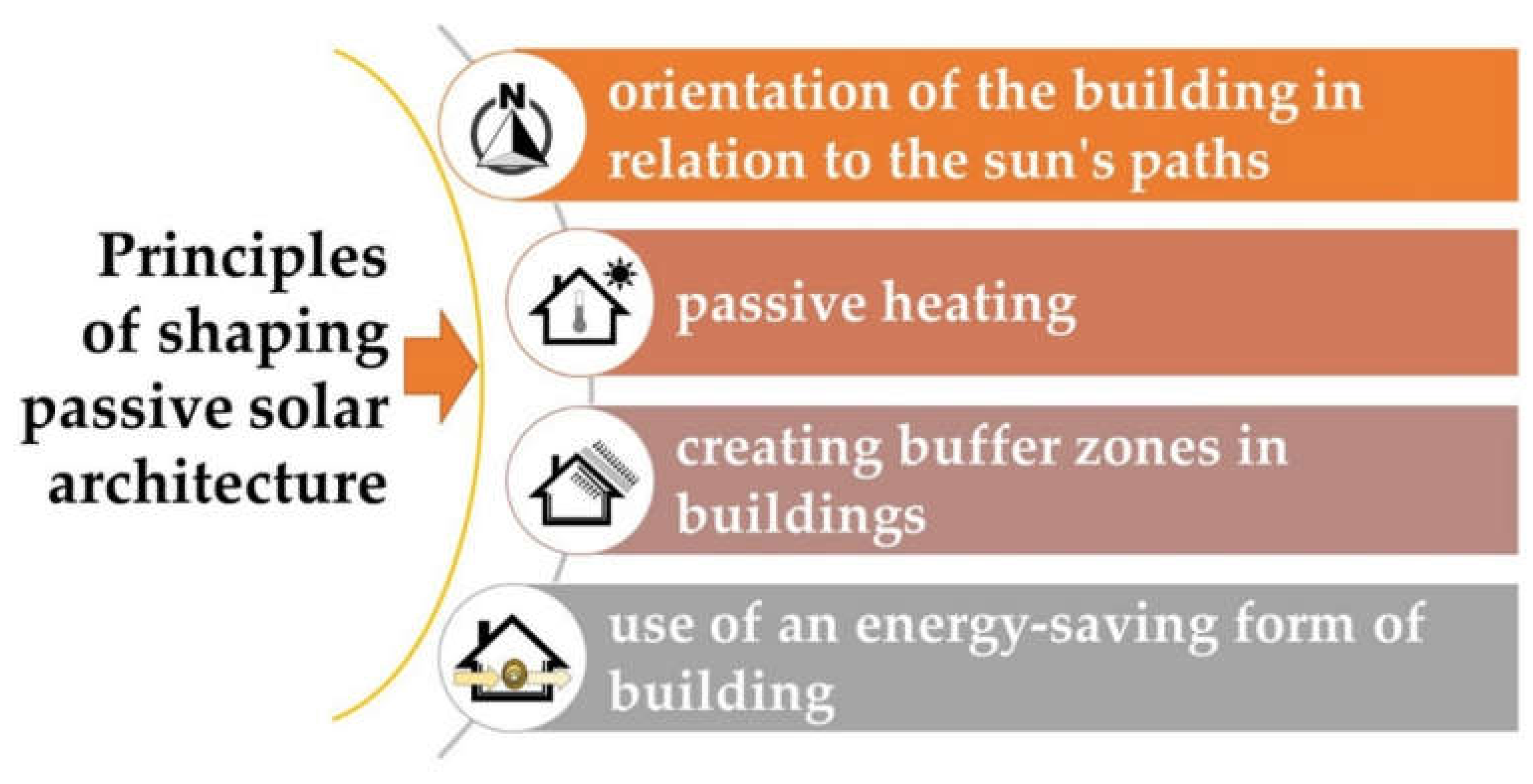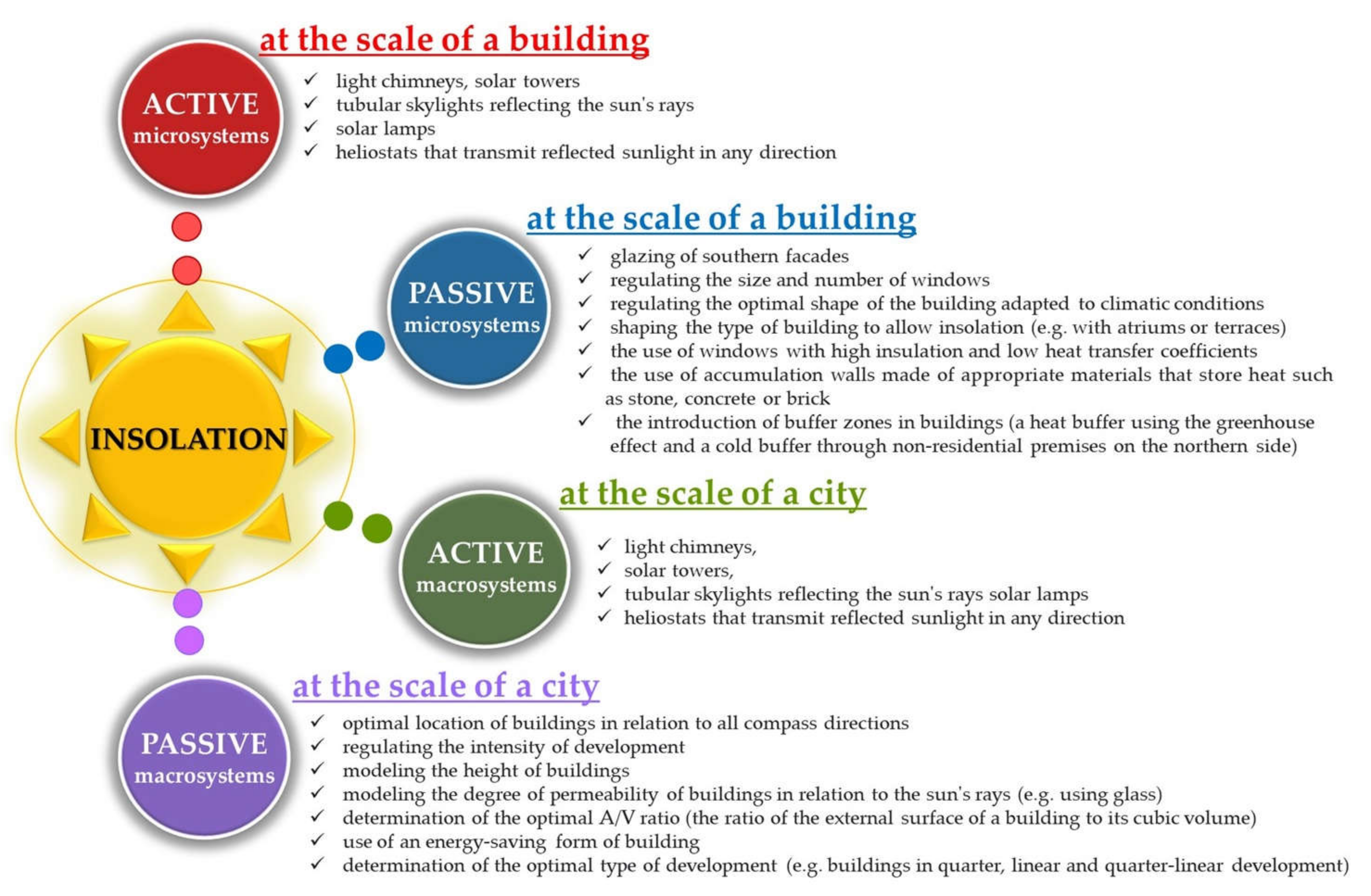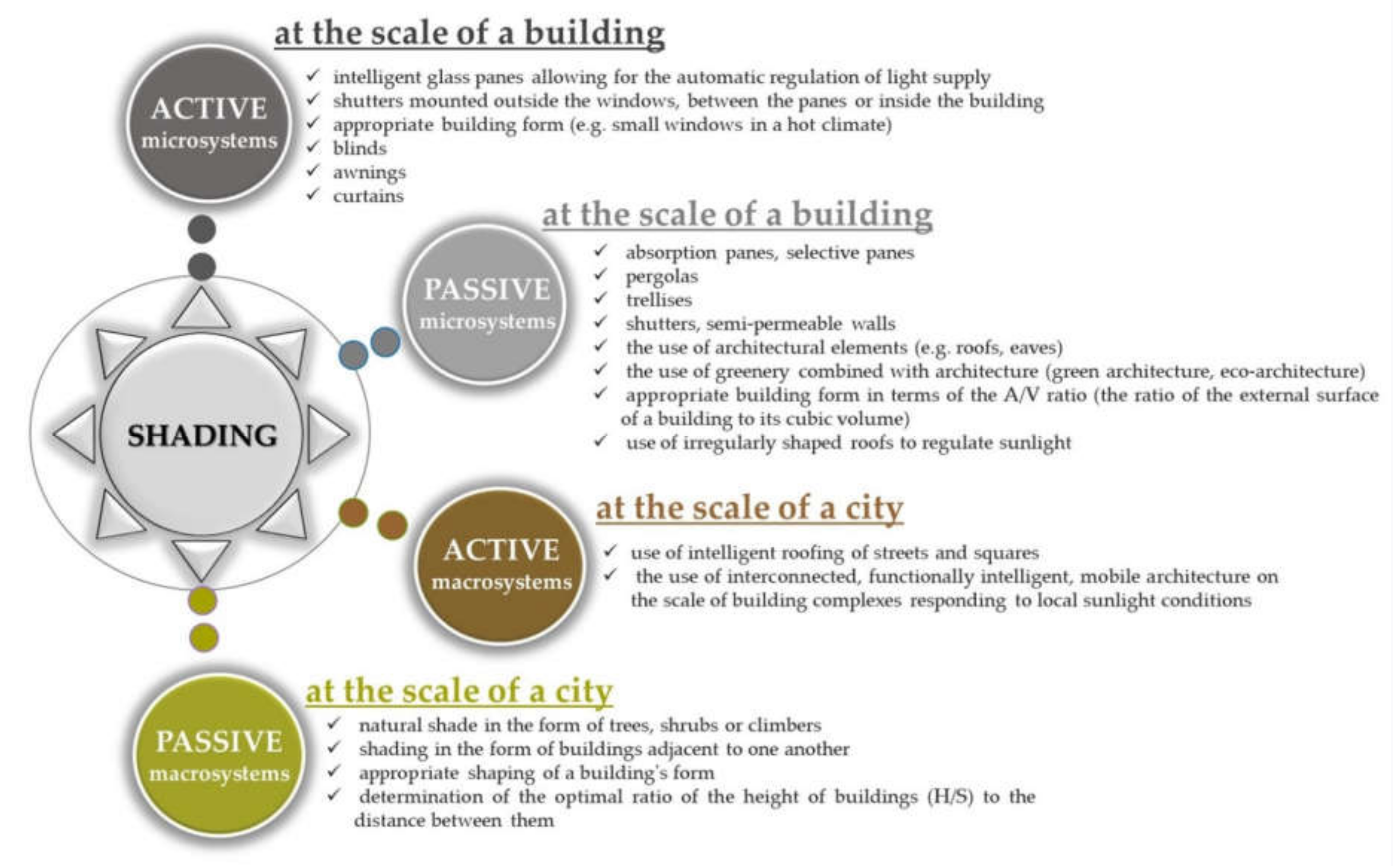Passive and Active Solar Systems in Eco-Architecture and Eco-Urban Planning
Abstract
:1. Introduction
2. Materials and Methods
2.1. Solar Architecture and Solar Urban Planning: The State of the Art
2.1.1. The Health-Promoting Role of the Sun
2.1.2. Solar Architecture from Antiquity to Modernism
2.1.3. The Use of the Sun in Urban Planning
3. Research: Passive and Active Solar Systems in Eco-Architecture and Eco-Cities
3.1. Passive and Active Systems in Solar Architecture
- orientation;
- passive heating;
- creating buffer zones in buildings (a heat buffer using the greenhouse effect and a cold buffer using non-residential premises located on the north side) [9];
- use of an energy-saving form of building.
3.2. Passive and Active Systems in Solar Urban Planning
3.3. Heliostats and Their Application
3.3.1. Heliostats: Technological Aspects
3.3.2. Heliostats: Selected Case Studies of Urban Design
3.4. Multi-Scale Model of Passive and Active Solar Systems
4. Discussion
5. Conclusions
Author Contributions
Funding
Institutional Review Board Statement
Informed Consent Statement
Data Availability Statement
Conflicts of Interest
References
- Legény, J.; Morgenstein, P.; Spacek, R. Sustainable urban design. A solar strategy for a sustainable city. Archit. Urban. 2014, 48, 38–53. [Google Scholar]
- Lepore, M. The right to the sun in the urban design. VITRUVIO Int. J. Archit. Technol. Sustain. 2017, 2, 25–43. [Google Scholar] [CrossRef] [Green Version]
- Available online: http://www.loc.gov/item/sn83030272/1916–01–28/ed-1 (accessed on 23 October 2021).
- Bucholc, K. Słońce we wnętrzu–od użyteczności do śladów ducha. Przestrz. Ekon. Społecz. 2018, 13, 9–23. [Google Scholar]
- Kanters, J.; Dubois, M.C.; Wall, M. Architects’ design process in solar-integrated architecture in Sweden. Archit. Sci. Rev. 2013, 56, 141–151. [Google Scholar] [CrossRef]
- Ragheb, A.; El-Shimy, H.; Ragheb, G. Green architecture: A concept of sustainability. Procedia Soc. Behav. Sci. 2016, 216, 778–787. [Google Scholar] [CrossRef] [Green Version]
- Seidler, H. Sunlight and Architecture. Archit. Sci. Rev. 1959, 2, 47–48. [Google Scholar] [CrossRef]
- Feria, M.; Amado, M. Architectural Design: Sustainability in the Decision-Making Process. Buildings 2019, 9, 135. [Google Scholar] [CrossRef] [Green Version]
- Baker, N.; Steemers, K. Energy and Environment in Architecture: A Technical Design Guide, 1st ed.; Taylor & Francis: London, UK, 2000. [Google Scholar]
- Jankowski, C. Jak Chronić Dom Przed Nadmiernym Nasłonecznieniem. Available online: https://budownictwob2b.pl/okna-i-dkieta/baza-wiedzy/51055-jak-chronic-dom-przed-nadmiernym-nasloneczeniem (accessed on 23 October 2021).
- Perlin, J.; Lovins, A. Let It Shine: The 6000-Year Story of Solar Energy; Revised edition; New World Library: Novato, CA, USA, 2013. [Google Scholar]
- Siret, D. Le Corbusier Plans. 1940-Studies in Sunlight (No Place), English version. Le Corbusier, DVD N°7; Fondation Le Corbusier: Paris, France, 2006. [Google Scholar]
- Evans, J.M.; Schiller, S. The friendly city, the sun and Le Corbusier: Form, function and bioclimatic response. In Environmentally and Friendly Cities, Proceedings of PLEA 98, Lisbon, Portugal, June 1998; James & James: London, UK, 1998. [Google Scholar]
- Lobaccaro, G.; Croce, S.; Lindkvist, C.; Munari Probst, M.C.; Scognamiglio, A.; Dahlberg, J. A cross-country perspective on solar energy in urban planning: Lessons learned from international case studies. Renew. Sust. Energ. Rev. 2019, 108, 209–237. [Google Scholar] [CrossRef]
- Lobaccaro, G.; Frontini, F. Solar energy in urban environment: How urban densification affects existing buildings. Energy Procedia 2014, 48, 1559–1569. [Google Scholar] [CrossRef] [Green Version]
- Amando, M.; Poggi, F. Towards Solar Urban Planning: A New Step for Better Energy Performance. Energy Procedia 2012, 30, 1261–1273. [Google Scholar] [CrossRef] [Green Version]
- Mirakyan, A.; De Guio, R. Integrated energy planning in cities and territories: A review of methods and tools. Renew. Sustain. Energy Rev. 2013, 22, 289–297. [Google Scholar] [CrossRef]
- Zielonko-Jung, K. Ecological Technologies for Urban Buildings—Research Directions. Kwartalnik Naukowy Uczelni Vistula 2017, 4, 142–152. [Google Scholar]
- Sarralde, J.J.; Quinn, D.J.; Wiesmann, D.; Steemers, K. Solar energy and urban morphology: Scenarios for increasing the renewable energy potential of neighbourhoods in London. Renew. Energy 2015, 73, 10–17. [Google Scholar] [CrossRef] [Green Version]
- Abbas, A.; Danish, S.; Abdelrahman, E.; Hany, A.; Yang, D. A review and classification of layouts and optimization techniques used in design of heliostat fields in solar central receiver systems. Sol. Energy 2021, 218, 296–311. [Google Scholar]
- Wajss, P.; Filipowicz, M. A new approach to the design of a heliostat and its operating principles. In Proceedings of the Conference, Solar Power International 2016, Las Vegas, NV, USA,, 12–15 September 2016. [Google Scholar]
- Kanters, J.; Horvat, M. Solar energy as a design parameter in urban planning. Energy Procedia 2012, 30, 1143–1152. [Google Scholar] [CrossRef] [Green Version]
- Darula, S.; Christoffersen, J.; Malikova, M. Sunlight and insolation of building interiors. Energy Procedia 2015, 78, 1245–1250. [Google Scholar] [CrossRef] [Green Version]
- Roelandts, R. The history of phototherapy: Something new under the sun? J. Am. Acad. Dermatol. 2002, 46, 926–930. [Google Scholar] [CrossRef]
- Hobday, R.A. Sunlight therapy and solar architecture. Med. Hist. 1997, 41, 455–472. [Google Scholar] [CrossRef] [Green Version]
- Greenhalgh, I.; Butler, A.R. Sanatoria revisited: Sunlight and health. J. R. Coll. Physicians Edinb. 2017, 47, 276–280. [Google Scholar] [CrossRef]
- Butti, K. A Golden Thread: 2500 Years of Solar Architecture and Technology. In Van Nostrand Reinhold, 1st ed.; Cheschire Books: Palo Alto, CA, USA.
- Wehle-Strzelecka, S. Energia Słońca w Kształtowaniu Środowiska Mieszkaniowego-Ewolucja Koncepcji na Przestrzeni Wieków; Wydawnictwo Politechniki Krakowskiej: Kraków, Poland, 2014. [Google Scholar]
- Vitruvius. The Ten Books on Architecture; Harvard University Press: Cambridge, MA, USA, 1914. [Google Scholar]
- Kuczia, P. Insolacja przestrzeni architektonicznej a zdrowie i samopoczucie człowieka. Zesz. Nauk Archit. Politech Śląska 2009, 48, 105–116. [Google Scholar]
- Murgul, V.; Vatin, N.; Zayats, I. The Role of the Solar Light Quantity in the Architectural Forming of Buildings. Procedia Eng. 2015, 117, 819–824. [Google Scholar] [CrossRef] [Green Version]
- Atkinson, W. The Orientation of Buildings or Planning for Sunlight; John Wiley & Sons: New York, NY, USA, 1912. [Google Scholar]
- Wiginton, L.K.; Nguyen, H.T.; Pearce, J.M. Quantifying rooftop solar photovoltaic potential for regional renewable Energy policy. Comput. Environ. Urban Syst. 2010, 34, 345–357. [Google Scholar] [CrossRef] [Green Version]
- Leonardi, E.; Pisani, L.; Les, I.; Larrayoz, A.M.; Rohani, S.; Schöttl, P. Techno-economic heliostat field optimization: Comparative analysis of different layouts. Solar Energy 2019, 180, 601–607. [Google Scholar] [CrossRef]
- Wajss, P.; Filipowicz, M. Charakterystyka heliostatów i ich zastosowanie w helioelektrowniach. J. Civ. Eng. Environ. Archit. 2017, 34, 423–430. [Google Scholar] [CrossRef] [Green Version]
- Ashley, T.; Carrizosa, E.; Fernandez-Cara, E. Heliostat field cleaning scheduling for Solar Power Tower plants: A heuristic approach. Appl. Energy 2018, 235, 653–660. [Google Scholar] [CrossRef]
- Collado, F. A review of optimized design layouts for solar power tower plants with campo code. Renew. Sustain. Energy Rev. 2013, 20, 142–154. [Google Scholar] [CrossRef] [Green Version]
- Lehmann, A.; Ekins-Daukes, N.J. Ultraviolet Light Management in Building Integrated Solar Lighting Systems. In Proceedings of the Conference Asia-Pacific Solar Research Conference, Sydney, Australia, 3–5 December 2019. [Google Scholar]
- Available online: https://www.mvvainc.com/project.php?id=2&c=parks. (accessed on 23 October 2021).
- Available online: https://global.ctbuh.org/resources/papers/download/1836-case-study-one-central-park-sydney.pdf (accessed on 23 October 2021).
- Available online: https://www.ipcn.nsw.gov.au/resources/pac/media/files/pac/projects/2018/01/request-for-review-of-gateway-determination-for-197-and-207-church-st-and-89-marsden-st-parramatta/gateway-review-documents/appendix-13-inhabit-heliostat-installation-report-on-197-church-street.pdf (accessed on 23 October 2021).
- Givoni, B. Climate Considerations in Building and Urban Design; John Wiley & Sons: New York, NY, USA, 1998. [Google Scholar]
- Ratti, C.; Raydan, D.; Steemers, K. Building form and environment performance: Archetypes, analysis and an arid climate. Energy Build. 2003, 35, 49–59. [Google Scholar] [CrossRef]
- Lewińska, J. Klimat, Miasta, Zasoby, Zagrożenia, Kształtowanie; Instytut Gospodarki Przestrzennej i Komunalnej: Kraków, Poland, 2000. [Google Scholar]
- Zaręba, A.; Krzemińska, A.; Dzikowska, A. Urban Green Network-Synthesis of Environmental, Social and Economic Linkages in Urban Landscape. IOP Conf. Ser. Earth Environ. Sci. 2019, 362. [Google Scholar] [CrossRef]
- Kozik, R. Application of multi-criteria decision analysis in selecting of sustainable investments. In Proceedings of the International Conference of Numerical Analysis and Applied Mathematics 2016 (ICNAAM 2016), Rhodes, Greece, 19–25 September 2016. [Google Scholar]




Publisher’s Note: MDPI stays neutral with regard to jurisdictional claims in published maps and institutional affiliations. |
© 2022 by the authors. Licensee MDPI, Basel, Switzerland. This article is an open access article distributed under the terms and conditions of the Creative Commons Attribution (CC BY) license (https://creativecommons.org/licenses/by/4.0/).
Share and Cite
Zaręba, A.; Krzemińska, A.; Kozik, R.; Adynkiewicz-Piragas, M.; Kristiánová, K. Passive and Active Solar Systems in Eco-Architecture and Eco-Urban Planning. Appl. Sci. 2022, 12, 3095. https://doi.org/10.3390/app12063095
Zaręba A, Krzemińska A, Kozik R, Adynkiewicz-Piragas M, Kristiánová K. Passive and Active Solar Systems in Eco-Architecture and Eco-Urban Planning. Applied Sciences. 2022; 12(6):3095. https://doi.org/10.3390/app12063095
Chicago/Turabian StyleZaręba, Anna, Alicja Krzemińska, Renata Kozik, Mariusz Adynkiewicz-Piragas, and Katarina Kristiánová. 2022. "Passive and Active Solar Systems in Eco-Architecture and Eco-Urban Planning" Applied Sciences 12, no. 6: 3095. https://doi.org/10.3390/app12063095






